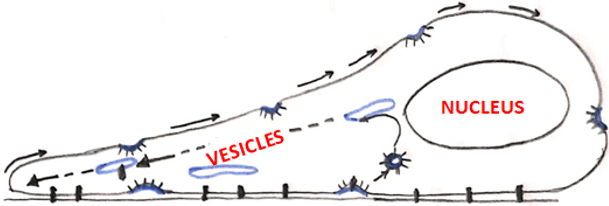This set of Tissue Engineering Multiple Choice Questions & Answers (MCQs) focuses on “Cell Migration”.
1. The cell’s directed movement as a response to a mechanical or/and chemical signal is termed as ______________
a) cell adhesion
b) cell death
c) cell division
d) cell migration
View Answer
Explanation: The cell’s directed movement as a response to a mechanical or/and chemical signal is termed as cell migration. Cell migration is a primary cellular process occurring lifelong, it starts during the embryonic development and continues till death, and sometimes it could be the reason for certain pathogenic states while a disease takes place.
2. What is shown in the following diagram?

a) Actin polymerization
b) Keratin polymerization
c) Collagen polymerization
d) Fiber contraction
View Answer
Explanation: Experiments have shown that rapid actin polymerization happens at the front edge of the cell. This observation led to the hypothesis that actin filaments are formed by “pushing” the leading edge in the forward direction.
3. What is shown in the following diagram?

a) Endocytosis
b) Division
c) Apoptosis
d) Exocytosis
View Answer
Explanation: Actin filaments formed might help in the stabilization of the added membrane which is followed by a structured extension instead of a bubble-like structure at its front. For the cell to move a new set of CAMs (integrins) is required at the front. It is likely that these integrins are endocytosed toward the back end and brought to the cell’s front end by exocytosis to be reused as new attachments for the substrate.
4. Migrating cells possess photoluminescence.
a) TRUE
b) FALSE
View Answer
Explanation: Cells that move have a front and back polarity. Without this polarity, they would be moving in all the directions in one go.
5. Adhesive crawling is the only migration mode exhibited in eukaryotic cells.
a) TRUE
b) FALSE
View Answer
Explanation: Adhesive crawling is not the only migration mode exhibited by eukaryotic cells. Even metastatic cancer cells and immune cells like macrophages and neutrophils are capable of migration independent of adhesion.
Sanfoundry Global Education & Learning Series – Tissue Engineering.
To practice all areas of Tissue Engineering, here is complete set of 1000+ Multiple Choice Questions and Answers.
If you find a mistake in question / option / answer, kindly take a screenshot and email to [email protected]
- Check Tissue Engineering Books
- Check Biotechnology Books
- Practice Biotechnology MCQs
- Apply for Biotechnology Internship
